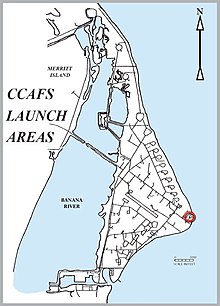The SM-65 Atlas was the first operational intercontinental ballistic missile (ICBM) developed by the United States and the first member of the Atlas rocket family. It was built for the U.S. Air Force by the Convair Division of General Dynamics at an assembly plant located in Kearny Mesa, San Diego). Atlas became operational as an ICBM in October 1959 and was quickly obsoleted by new development, being retired as a missile by 1965. The Atlas required extremely long preparation times which made it unsuitable for a quick launch ICBM. However, this was not a requirement for planned space launches, and so Atlas-derived launch vehicles served a long history as space launchers.

Vandenberg Air Force Base is a United States Air Force Base located 9.2 miles (14.8 km) northwest of Lompoc, California. The installation falls under the jurisdiction of the 30th Space Wing, Air Force Space Command (AFSPC).

The Martin Marietta SM-68A/HGM-25A Titan I was the United States' first multistage intercontinental ballistic missile (ICBM), in use from 1959 until 1962. Though the SM-68A was operational for only three years, it spawned numerous follow-on models that were a part of the US arsenal and space launch capability. The Titan I was unique among the Titan models in that it used liquid oxygen and RP-1 as propellants. All subsequent versions used storable propellants instead.

Cape Canaveral Air Force Station (CCAFS) is an installation of the United States Air Force Space Command's 45th Space Wing.

The 91st Missile Wing is a United States Air Force unit assigned to the Air Force Global Strike Command Twentieth Air Force. It is stationed at Minot Air Force Base, North Dakota as a tenant unit.

Cape Canaveral Air Force Station Space Launch Complex 17 (SLC-17), previously designated Launch Complex 17 (LC-17), was a launch site at Cape Canaveral Air Force Station, Florida used for Thor and Delta rocket launches between 1958 and 2011.
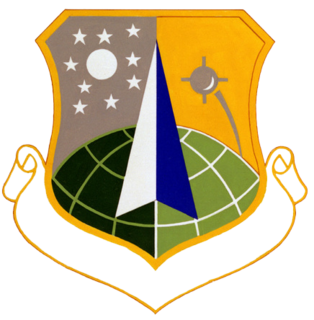
The Eastern Range (ER) is an American rocket range that supports missile and rocket launches from the two major launch heads located at Cape Canaveral Air Force Station and the Kennedy Space Center (KSC), Florida. The range has also supported Ariane launches from the Guiana Space Centre as well as launches from the Wallops Flight Facility and other lead ranges. The range also uses instrumentation operated by NASA at Wallops and KSC.
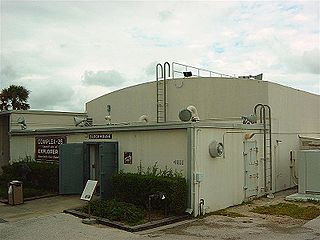
Launch Complex 26 (LC-26) is a deactivated launch site at Cape Canaveral Air Force Station, Florida. LC-26 consisted of two pads, A and B. Pad A was used for the Jupiter-C and Juno I rockets, and was the launch site for Explorer 1, the United States' first satellite, in 1958. Pad B was used for Juno II. Jupiter IRBMs were launched from both pads.

Missile Row was a nickname given in the 1960s to the US Air Force and NASA launch complexes at Cape Canaveral Air Force Station (CCAFS). Operated by the 45th Space Wing of the U.S. Air Force since 1949, it was the site of all pre-Apollo 8 manned launches, as well as many other early Department of Defense (DoD) and NASA launches. For the DoD, it plays a secondary role to Vandenberg AFB in California, but is the launch site for many NASA unmanned space probes, as those spacecraft are typically launched on Air Force launchers. Active launch vehicles are in bold.

The 45th Space Wing is a United States Air Force unit. It is assigned to the Fourteenth Air Force, stationed at Patrick Air Force Base, Florida. It commands Patrick AFB and the Cape Canaveral Air Force Station. The mission of the 45th Space Wing is to assure access to space and to support global operations.

The Air Force Space and Missile Museum is located at Launch Complex 26 at Cape Canaveral Air Force Station, Florida. It includes artifacts from the early American space program and includes an outdoor rocket garden displaying rockets, missiles and space-related equipment chronicling the US Air Force.

Space Launch Complex 10, or Missile Launch Complex 10, is located on Vandenberg Air Force Base in Lompoc, California. It was built in 1958 to test ballistic missiles and developed into a space launching facility in 1963. Prior to 1966 Space Launch Complex 10 West was known as Vandenberg AFB Pad 75-2-6. It remains a rare pristine look at the electronics and facilities created in that era that helped the United States grow its space capabilities.

The United States Air Force's 1st Space Launch Squadron was a space launch unit located at Cape Canaveral Air Force Station, Florida. It was responsible for USAF Delta II launches from its activation in October 1990 to its inactivation in August 2009.
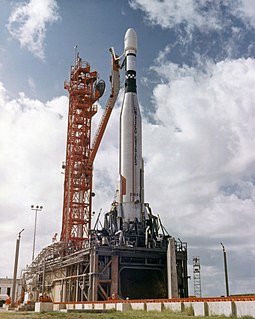
Launch Complex 13 (LC-13) was a launch complex at Cape Canaveral Air Force Station, the third-most southerly of the original launch complexes known as Missile Row, lying between LC-12 and LC-14. The LC-13 site is currently leased by SpaceX and has been renovated for use as Landing Zone 1 and Landing Zone 2, their east coast landing location for returning Falcon 9 and Falcon Heavy launch vehicle booster stages.

The Spaceport Florida Launch Complex 46 (SLC-46) is a launch complex at Cape Canaveral Air Force Station operated under license by Space Florida for Athena rocket launches.

Launch Complex 16 (LC-16) at Cape Canaveral Air Force Station, Florida is a launch complex built for use by LGM-25 Titan missiles, and later used for NASA operations before being transferred back to the US military and used for tests of MGM-31 Pershing missiles. Six Titan I missiles were launched from the complex between December 1959 and May 1960. These were followed by seven Titan II missiles, starting with the type's maiden flight on March 16, 1962. The last Titan II launch from LC-16 was conducted on May 29, 1963.
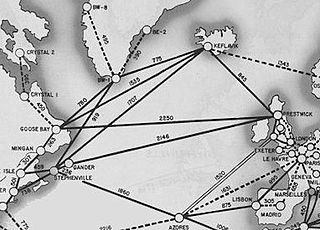
Presque Isle Air Force Base was a military installation of the United States Air Force in Maine. In the late 1950s and early 1960s it became a base for Strategic Air Command.

The Operational Silo Test Facility (OSTF) is a former United States Air Force intercontinental ballistic missile launch facility at Vandenberg Air Force Base, California, United States. It was a developmental launch site for the silo-based Titan and Atlas missile series.

Cape Canaveral Air Force Station Launch Complex 47 is a launch pad for sounding rockets located at the north end of Cape Canaveral Air Force Station, Florida. It is the smallest launch complex used in the air force station. The complex features a small blockhouse a few yards from the pad, containing vehicle-specific hardware. Between 1984 and 2008, 531 sounding rockets were launched from pad 47. All weather rocket operations were relocated here from Launch Complex 43 in 1984 in order to make room for the construction of Launch Complex 46.
